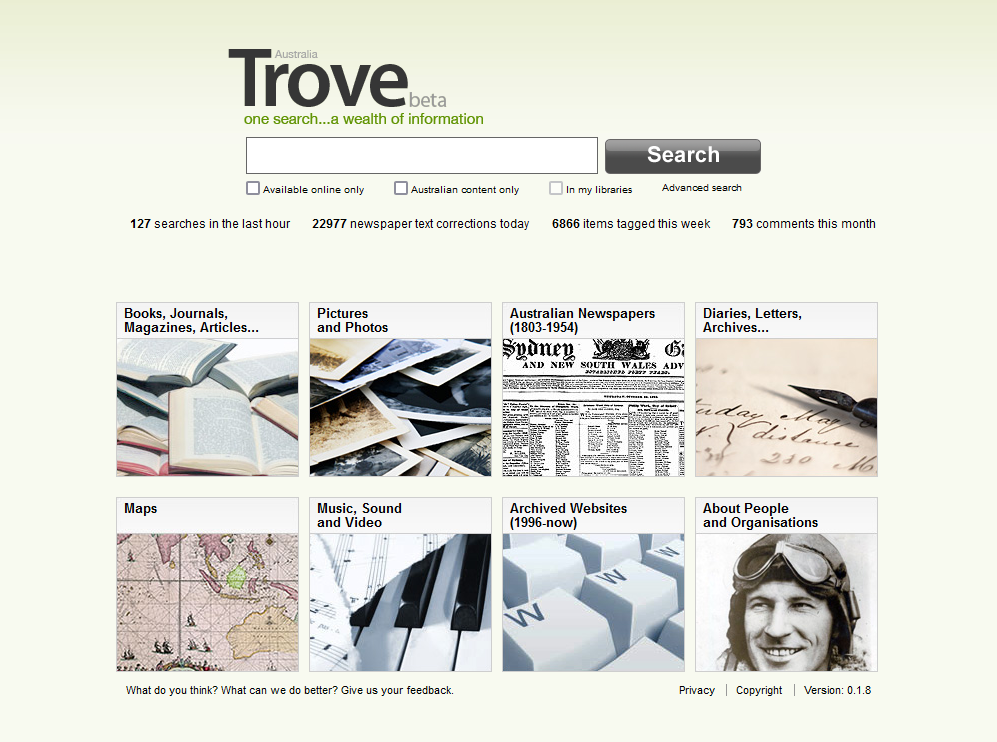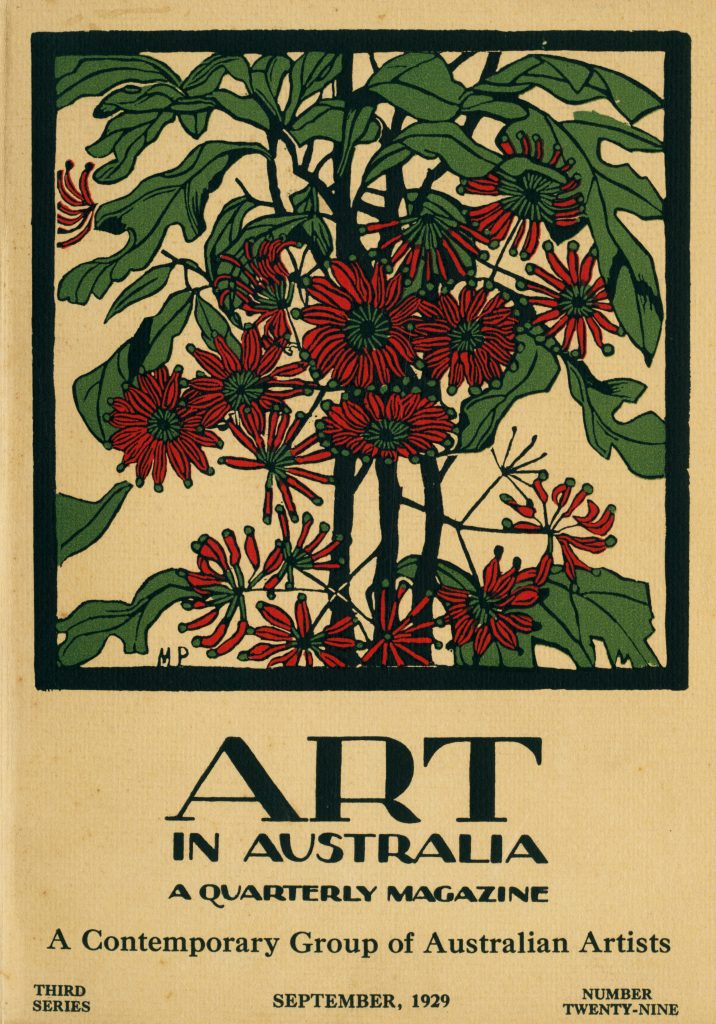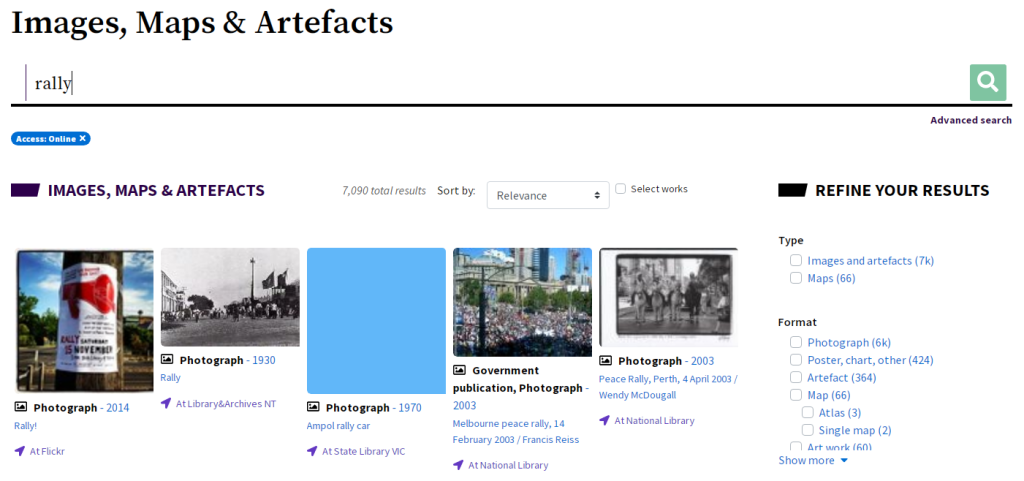On any given day here at State Library Victoria you may hear librarians wax lyrical about the wonders of Trove. Yet for many library users it can be a bit of a mystery. So what is Trove, how do librarians at State Library Victoria use it and why should you use it, too? (Hint: it’s free!)
What is Trove?
Trove is a website for both the public and professionals that is a ‘single point of entry to a treasure trove of artefacts, curiosities and stories from Australia’s cultural, community and research institutions.’1 The National Library of Australia (who established Trove in 2009) is the main operator of the website, and works closely with Trove’s Principal Partners (State Library New South Wales, State Library of Queensland, State Library of Western Australia, and State Library Victoria) as well as hundreds of other partners around Australia.

There are numerous computer programs that operate collection management for over 6 billion records of cultural heritage items, that have been uploaded to Trove from libraries, museums, galleries, and archives from all over Australia. The Trove website provides a user interface that helps bring the many elements together to make them easily searchable in one place.
What can you find on Trove?
Trove has a massive amount of content and it sorts items into major categories:
- Newspapers & Gazettes
- Magazines & Newsletters
- Images, Maps & Artefacts
- Research & Reports
- Books and Libraries
- Diaries, Letters & Archives
- Music, Audio & Video
- People & Organisations, and
- Websites
These categories can be searched individually or all together.
The search results will deliver both fully digital items to view and download, as well as links to listings of physical material kept in specific libraries, museums, galleries and archives.
Digitally available items
The Newspapers & Gazettes and Magazines & Newsletters categories contain millions of digitally viewable and downloadable pages. There are hundred of digitised newspapers and magazines, covering Australia’s metropolitan and regional areas, with more being added all the time.

You can find vintage knitting and crochet patterns and retro recipes, or browse through historical newspapers for your local area. Nearly everyone has experienced their 15 minutes of fame courtesy of a newspaper, or knows someone who has. In this way, Trove makes the history of Victorians accessible not just to all corners of Victoria, but all corners of the world. Trove allows a full text search of these items with a simple query.
The Images, Maps and Artefacts category contains links to millions of digitised images. Many collecting institutions have freely available digitised photos and paintings, and Trove allows you to search all across Australia for a picture that suits your needs.
Other categories have a mixture of items ready to download, or link into the catalogue of the relevant libraries, museums, galleries, and archives to investigate further.
National edeposit materials
You can also use Trove to access legal deposit publications that have been deposited via the National edeposit service (or NED). Publishers can set their own access permissions so while some publications need to be viewed onsite at your State or National Library, many can be viewed via Trove from home.
How do librarians at State Library Victoria use Trove?
Trove is a many faceted website, so it may come as no surprise that librarians at State Library Victoria use it in many different ways. Many elements of Trove contribute to core duties undertaken by library staff at State Library Victoria, in areas such as collection management, and website archiving.

Much research undertaken by our librarians utilise the various resources included on Trove. Be it family history information where articles and family notices are published in small town newspapers, researching the history of a house or a building, detailed historical documents included in the Australian Joint Copying Project, or obscure reports on a wide range of topics, these are all just a quick search away with Trove. Another practical use of Trove by librarians is the ability to search library catalogues across Australia. This function allows librarians to identify the different libraries that hold certain books, magazines, newspapers and other materials that library users are interested in but are not held by State Library Victoria.
How can you use Trove?
This has been a very librarian-focused article, but please do not think that it is only librarians who use Trove. The general public, enthusiasts, amateur and professional researchers all love and use Trove for a myriad of reasons, including historical newspaper research with digitized newspapers, local/Victorian/ Australian history information and family history. There are thousands of people out there using Trove daily for all sorts of research. It is a website that has been designed for everyone, so with a few searches you should hopefully find Trove as fascinating as we do.
One of the great features of Trove is the ability to tag different records, articles, books etc, creating user lists. This can benefit other researchers by making records and materials easier and quicker to search. Another crowd-sourced improvement of Trove is the volunteer work undertaken to correct the full text of digitised newspaper articles. If you are keen to help, you can become a ‘Voluntrove’. It is a very valuable service that is appreciated by all Trove users (not to mention being quite fun and not a little addictive).

This article has described Trove in a nutshell, but it really is so much more. Trove has provided free, equitable, instant access for the public to their history. It truly is Australia’s gateway to its cultural and intellectual history and we encourage you to explore it – with only a few searches and clicks, you might discover some treasure as well.
- Trove, 2023, What is Trove, viewed 14 March, 2023, <https://trove.nla.gov.au/about/what-trove>



Trove is also a source of data for new forms of digital research. See the Trove sections of the GLAM Workbench for some examples of the possibilities: https://glam-workbench.net/
Thanks for your comment, Tim. This is a fascinating area of research. Thanks for the link to the website.
Thanks very much for your article, Alex, do you know when there might be a response from the government re funding TROVE?
Dear Annette, we’re glad you enjoyed the blog post. Some exciting news yesterday that had us all very happy at the Library: https://trove.nla.gov.au/announcement/2023/04/03/national-library-welcomes-announcement-ongoing-trove-funding